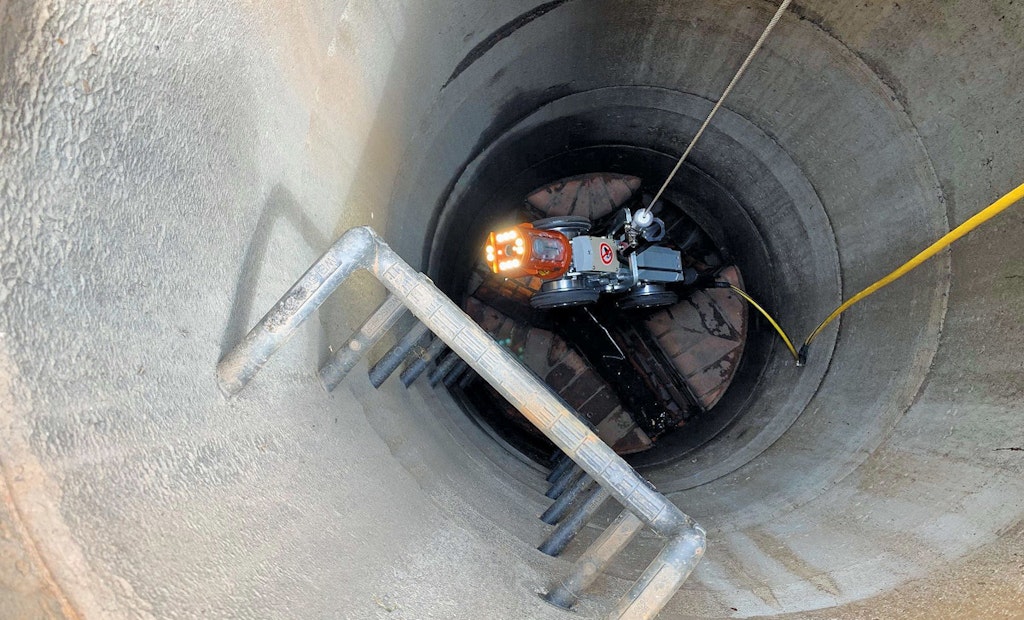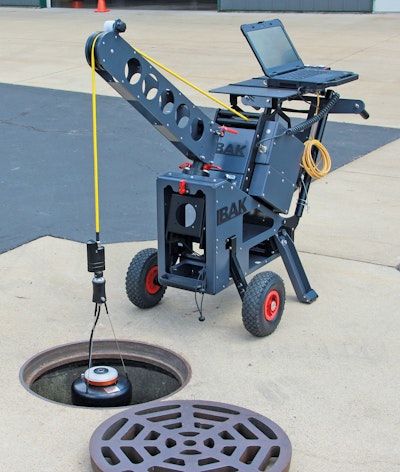
When it’s time to purchase an inspection system, communicate your goals and budget to equipment manufacturers, get to know the companies and try to understand the true cost of ownership of a piece of equipment.
Interested in Inspection?
Get Inspection articles, news and videos right in your inbox! Sign up now.
Inspection + Get AlertsIf you operate a collections system, you’re more than familiar with inflow and infiltration, roots, joint misalignment, collapsed pipe, corrosion, cross bores and other maladies. Whether you find those problems early or discover them when an emergency arises is often dependent on your inspection program.
RapidView was formed in 1991 with a focus on bringing good equipment and service to the people who needed it. Today, RapidView IBAK North America is a top provider of inspection equipment for contractors and municipal utilities. And good equipment is at least part of a good inspection program.
Municipal Sewer & Water recently spoke to Matt Sutton, vice president of sales and marketing for RapidView, about the company, its customers and how sewer inspection is evolving.
MSW: Tell us a little about the history of RapidView and how it got started.
Sutton: The RapidView team grew up in the sewer industry. We were members of family-owned businesses that were inspection contractors, septic pumpers, pipeline installers and manufacturers of technologies used in the sewer industry. Because of our contractor- and service-based backgrounds, we understood the importance of high-quality equipment. We also knew that spare parts availability and repairability are perhaps the most important factors determining a user’s success with equipment. We were frustrated that we couldn’t purchase this level of technology and support locally, so we decided to form RapidView to provide those things to the North American market.
MSW: Can you explain the relationship with IBAK and how it has helped RapidView evolve and grow?
Sutton: RapidView IBAK North America is the exclusive partner for IBAK in the U.S., Canada and the English-speaking Caribbean Islands. This partnership was formed exclusively to service these markets and has grown to be the largest external market for IBAK products in the world.
MSW: What’s the most common problem you see your municipal customers facing and what mistakes do you see them making in their inspection efforts?
Sutton: Municipal customers face many challenges. They have a big job and limited resources to get it done. Devising an inspection and rehabilitation program for a system is not a simple task. Aside from those issues, the biggest difference we see between really successful programs and normal programs is people.
The most successful municipalities train employees well and foster a sense of ownership with the employee and tools that they use. It doesn’t really matter if it’s a dump truck, a set of hand tools or a pipeline inspection system — if the employee knows that they are responsible for a specific piece of equipment they take better care of it, and as a result, are much more productive in the long run. Municipalities that share equipment across multiple teams or many employees will find that the sense of ownership and responsibility is lessened, and repairs become more frequent. This seems pretty self-evident when you think about it, but in our experience, there is no better way to ensure success.
MSW: What are some recommendations for customers shopping for inspection systems?
Sutton: As with any large capital purchase, the selection of a pipeline inspection system can be tough, but there are some strategies to help make sure that you get equipment that meets your needs. Communicate your goals and budget to equipment manufacturers so they can tailor systems to meet those requirements.
Secondly, get to know the companies you are considering purchasing from. Did they give you good references? Are they responsive? Are they professional and knowledgeable? You may have this equipment for the next 10 to 15 years and you want to make sure that they will be able to support you effectively in the future. Can they provide you data on repair times, processes, training and support?
Third, try to understand the true cost of ownership of a piece of equipment. Poor-quality equipment, purchased cheaply, will break down more often, leading to higher repair bills, increased downtime, decreased employee safety and stress. Higher-quality equipment such as high-definition systems or systems with additional sensors and capabilities will provide you with better deliverables, which will lead to more accurate and effective decisions based on those deliverables/data. Making sound rehabilitation decisions based on high-quality imagery and data is a priority for every municipality.
MSW: How has your product line evolved to better meet the needs of municipal utilities with aging infrastructure and limited budgets?
Sutton: IBAK was the first manufacturer of pipeline inspection cameras in 1957. From that day forward, quality and innovation have been the focus. IBAK is responsible for most innovations in our industry over the intervening six decades including pan-and-tilt cameras, color cameras, camera tractors, lateral launch systems, data logging software, PANORAMO 360 technologies and other high-definition optics.
That commitment continues to this day with over 15% of the company dedicated to research and development. Quality continues to also be a focus and today all systems are manufactured to ISO9001 standards. As the world’s oldest and largest company in the market, our customers can be confident that we will support them with the best technology for years to come. Because municipalities have limited resources, it is important that their equipment performs well, stays in the field longer, and provides them with good high-quality deliverables.
MSW: What differentiates your line of inspection systems from the competition?
Sutton: While other companies focus on using consumer-grade parts and keeping their price lower, IBAK has focused on technical innovation, uncompromising quality, and value for long-term ownership. RapidView has focused on providing a network of best-in-class service and support for our equipment. We are also focusing on the technologies of the future that will make operators’ jobs safer, increase productivity and provide underground infrastructure system owners with higher-quality data with which to make better rehabilitation and maintenance decisions.
MSW: Do you sell direct to contractors and municipalities or go through distributors?
Sutton: We partner with local and regional dealers to provide equipment and support to our customers. Our partners are some of the best equipment dealers in the country and are a great resource to their customers. Our philosophy is to support these local professionals so that they have everything they need to help customers be successful.
MSW: What sort of training and support does RapidView offer?
Sutton: We view training and support as core to our value proposition. Our staff is professionally trained, our inventory control equipment is state-of-the-art, and our modern repair case management system keeps customers up to date throughout the repair process.
We offer training in operation, maintenance and general repair direct to our customers through in-person classes, instructional videos and online instruction. We support customers who have the technical expertise to conduct general repairs on their own equipment and will provide free training in regularly scheduled classes. Our detailed operator training is free when conducted at our facility and is perhaps the best insurance a system owner can get for their success. Every two years we also hold a multiday training event called SeptemberFest that brings hundreds of customers and potential customers to our facility in Rochester, Indiana, where we provide in-depth, owner-based repair and maintenance workshops.
Our support team utilizes process control tracking and state-of-the-art case management tools that keep customers up to date on their repairs throughout the process. They receive updates when the equipment arrives, when it is put on the bench, when it is diagnosed, when it is repaired and when it is ready for shipment back. We collect data on our repair turnaround times and constantly make improvements to our process to ensure that customers get their equipment returned to them quickly. We stock $5 million worth of spare parts inventory at our headquarters in Indiana, and at our dealer service centers throughout North America. Our goal is to keep average repair times under 48 hours. Not every repair can be done so quickly, but we continually strive to improve our performance.
MSW: How do you see the subsurface inspection industry evolving as technology improves?
Sutton: We are focused on a few key areas. The first is increasing the quality of data and imagery. Providing users with higher-quality images, internal pipe geometry, three-dimensional pipeline tracking data, and AI-assisted coding will dramatically increase productivity and accuracy of inspections. Adoption of these technologies will increase the effectiveness of a customer’s rehabilitation decisions.
Secondly, we are focused on performance, usability and safety. These factors increase overall production, which is critical to help users with limited time and budgets meet their inspection goals, all while reducing operator stress and increasing employee safety. A utility’s mission is often so much bigger than the scope of their resources, so in the future we will need to empower them to do more with the resources they do have available.
MSW: What’s coming up for RapidView in 2021 and what can customers expect out of you in the future?
Sutton: In 2020 we began a large expansion of our headquarters in Rochester, Indiana. This expansion will dramatically increase the space available for service and software support. We are experiencing increased demand for our high-definition products, laser profiling, PANORAMO 4K technologies and 3D GeoSense pipeline tracking systems, and anticipate that this trend will continue. We are excited for what’s in store in the next few years.







